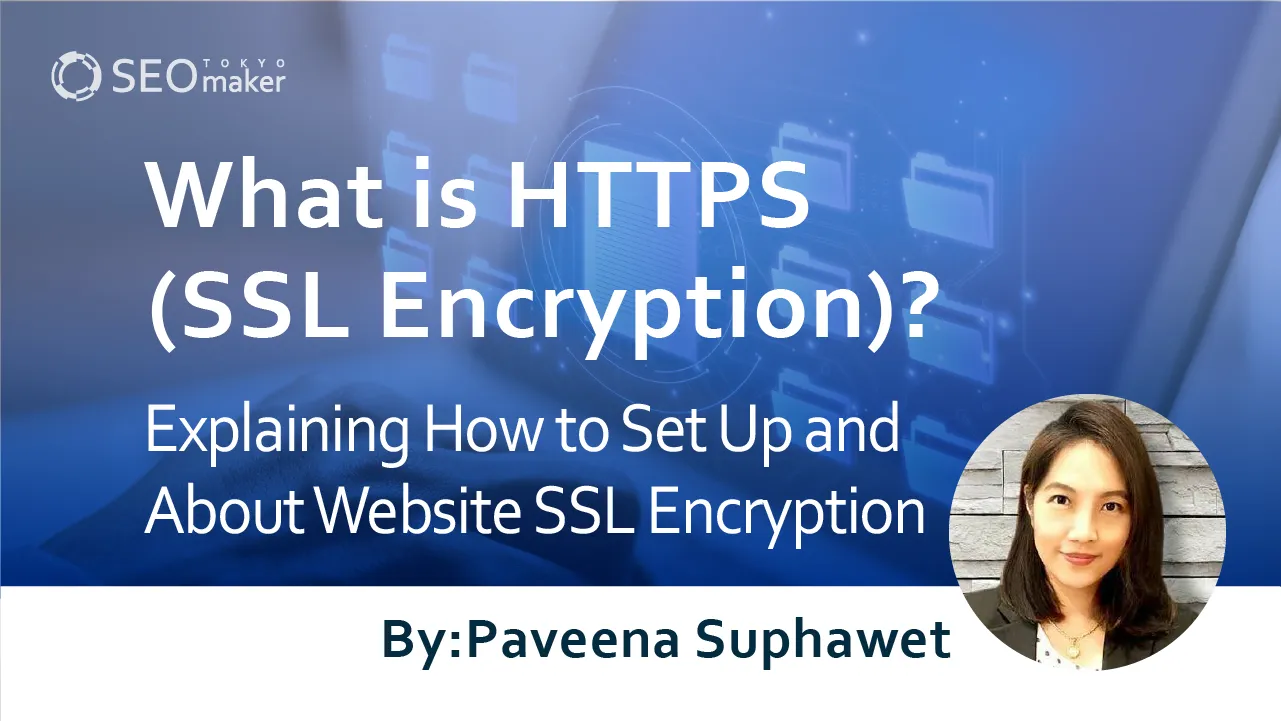What is HTTPS (SSL Encryption)? Explaining How to Set Up and About Website SSL Encryption
contents

Recently, encrypting websites with SSL has become a requirement. This is because SSL encryption secures data transfer, preventing interception and tampering by third parties. From an SEO perspective, websites with SSL encryption are rated higher, so it is imperative to encrypt your site with SSL.
Here, we will discuss the basics of SSL encryption, how to set it up, and what to watch out for.
What is SSL Encryption?
SSL stands for Secure Sockets Layer, a mechanism that encrypts communications on the Internet. The URL of a site not encrypted with SSL starts with http (unprotected communication), while an SSL-encrypted site’s URL starts with https.
Sites without SSL encryption do not encrypt data communication, making it easy for third parties to eavesdrop. To prevent information leaks through hacking, it is necessary to encrypt communication by SSL encryption.
In summary, SSL encryption is a setting that enhances the security of a site and protects it from external attacks.
What is Constant SSL Encryption?
Constant SSL encryption means encrypting not just the pages that contain personal information or other sensitive data but the entire site. The aim is to encrypt communications, which were not encrypted under traditional HTTP, at all times with HTTPS, thereby enhancing security.
Traditionally, SSL was used only on crucial pages of a website or pages where personal information was transmitted.
However, in recent times, with Google prioritizing websites that use HTTPS in search results, SSL encryption has been recommended.
About TLS
TLS (Transport Layer Security) is the successor protocol to SSL. A protocol is a set of rules or standards for data communication, and communications that violate these protocols cannot be correctly received. For example, SMTP is the protocol adopted for emails, necessary for their correct use.
TLS, like SSL, is a protocol for encrypting web communications. Specifically, it can prevent eavesdropping and tampering with information exchanged between browsers and servers, which would otherwise be in plain text.
About SSL/TLS Certificates SSL/TLS certificates certify that a website is using the SSL/TLS protocol to perform encrypted communication. There are various types of SSL/TLS certificates:
Domain Validation (DV) Certificates
DV certificates only certify the domain name of the website. They are issued after verifying the domain administrator’s authentication. Although the level of authentication is low, the procedure is simple, making these certificates widely used for many websites and blogs.
Organization Validation (OV) Certificates
OV certificates certify not only the highly domain name of the website but also the organization’s name, address, etc. The existence of the company is audited based on the certification authority’s standards. This level of certification is reliable and is mainly used for corporate websites.
Extended Validation (EV) SSL Certificates
EV SSL certificates have the highest level of authentication. They are often used by financial institutions and other organizations requiring the highest security level.
Reference page: “What are SSL/TLS Server Certificates?” – JIPDEC
The History of SSL/TLS Encryption
SSL, a protocol for encrypting web communications, was introduced in 1994. Initially, it was commonly used for financial transactions, such as online payments.
In 1995, SSL 2.0 was released and became widely used for HTTPS communications. However, vulnerabilities were discovered in 2006. SSL was upgraded to version 3.0 in 2008, but vulnerabilities found in 2014 led to its non-recommendation.
Currently, TLS (Transport Layer Security) has been developed and is widely used as the communication protocol replacing SSL.
Reasons Why It’s Better to Implement SSL Encryption
SSL encryption not only enhances security but also offers multiple benefits, making it recommended for websites of any size. Here are four specific reasons why it’s advantageous to implement SSL encryption:
- Increases Security
- Boosts Credibility with Site Visitors
- Offers SEO Advantages
- Enables Accurate Access Analysis and Site Analytics
Increases Security
Originally applied for security enhancement, the primary benefit of SSL encryption is the significant increase in security.
Sites without SSL encryption are at risk of leak easilying information. Considering the potential for customer personal information leaks, SSL encryption is a must for all sites, regardless of size. Just by encrypting with SSL, the risk of data leaks through tampering or impersonation is substantially reduced.
Boosts Credibility with Site Visitors
When visiting a site, if it’s not SSL encrypted, a warning of “unprotected communication” may appear in the site link. This warning can decrease the site’s credibility and potentially lead to visitor abandonment.
For instance, if you find a “unprotected communication” warning while searching for information or a corporate site, you might perceive the site as less credible and leave the page.
Losing customers or readers just because a site is not SSL encrypted is a significant waste. To enhance site credibility, SSL encryption is crucial.
Offers SEO Advantages
In 2014, Google announced that whether a site is SSL encrypted would be included as a factor in determining search rankings. Furthermore, in 2015, Google announced that between two pages with the same content, one SSL encrypted and the other not, the SSL- encrypted page would be prioritized for indexing.
Indexing means being registered with search engines like Google. Without SSL encryption, a site may not be indexed and thus not appear in search results. Being indexed is vital for getting more people to see your site.
Not having SSL encryption, resulting in limited site access or not appearing in Google searches, is a significant loss. From an SEO perspective, SSL encryption is essential.
Enables Accurate Access Analysis and Site Analytics
SSL encryption impacts significantly site management. For site operators, analyzing accurate search rankings and access numbers is indispensable.
Google Analytics, used by most site operators, performs more accurate analyses with SSL encryption. Without SSL, it’s impossible to understand the behavior of users visiting your site.
By implementing SSL encryption, you can determine how users arrive at your website. Understanding users’ movements between sites is a crucial element in growing site operations.
To protect and grow your site, SSL encryption is essential. Nowadays, SSL encryption can be relatively easily implemented on any server.
How to Implement SSL Encryption
The general steps for implementing SSL encryption are as follows:
- Issue and install an SSL server certificate
- Change the URL
- Set up redirects
- Make various setting changes
Issue and Install an SSL Server Certificate
First, apply for and install a server certificate. Typically, this process follows the server company’s manual, so refer to the manual provided by the server company you are using.
Depending on your server, the process of issuing and installing a server certificate may be significantly simplified.
Change the Link
At this point, SSL encryption has been implemented. However, external services are still registered with the pre-SSL http.
If a significant amount of time has passed since the site was created, it is recommended to implement SSL encryption as soon as the site is launched to avoid the hassle of post-SSL setting adjustments.
For various SNS links like Twitter, Facebook, and Instagram, where the site URL is shared, make sure to change them to https. Without redirect settings, site errors may be displayed.
Set Up Redirects
After SSL encryption, setting up redirects is necessary. Redirect settings ensure that accessing the previous http URL automatically forwards to the https URL.
When SSL is implemented, the URL changes from http to https. Without redirect settings, accessing the pre-SSL HTTP link could result in a page error, so don’t forget to set up redirects.
Make Various Setting Changes
After completing SSL encryption, check the settings for external services. Especially for Google Analytics and Google Search Console, which are essential for site operations, ensure the settings are correctly updated.
Post-SSL Settings for Google Analytics
Analytics is a crucial tool for analyzing site access. Not updating the settings can lead to inaccurate access analysis. There are two items to set in Google Analytics:
- Change the default URL in property settings to https://
- Change the website’s URL in view settings to https://
First, click the gear icon on the left sidebar of Google Analytics. Click on property settings and change the default URL to https://. Then, click the gear icon again, open view settings, and change the website’s URL to https:/ /.
Post-SSL Settings for Google Search Console
Google Search Console is a tool for checking indexing and search rankings. Like Analytics, update the settings to continue using it. After SSL encryption, you’ll need to add a new property in Search Console.
- Click on add property
- Enter the SSL-encrypted site’s URL in the domain
- Perform ownership verification
First, from the property dropdown at the top left of the homepage, click add property. Enter the SSL-encrypted https URL on the left side and click continue. Follow the instructions for ownership verification. This completes the settings change in Search Console.
How to Check if SSL Encryption is Implemented
After completing the settings, always check if SSL encryption is correctly implemented. To verify, check the site’s URL to see if it starts with https.
To ensure redirects are properly set, open an old http site link and check if it forwards to the new https site. This final check is crucial to ensure no mistakes were made during the setup process.
Frequently Asked Questions About SSL Encryption
Here, we address commonly asked questions about SSL encryption.
Q: How long is the validity of an SSL certificate?
A: SSL/TLS certificates have an expiration date. Once expired, a new certificate must be obtained.
Typically, the validity of an SSL certificate is one or two years, but this can vary depending on the type of certificate and the issuer. Using an expired certificate for communication will prompt a warning message from the browser, so be cautious.
Q: Does it affect the speed of the website?
A: The introduction of SSL/TLS increases the exchange of information between servers, which could potentially slow down display speeds. However, upgrades to SSL/TLS have minimized this impact. Web administrators should not be overly concerned about this effect.
Q: What should be considered before introducing SSL?
A: There are different types of SSL certificates, such as domain validation certificates and organization validation certificates. The choice of certificate determines the verification method by the certification authority, the time until approval, and how the certificate is displayed. Consider in advance which type of certificate is suitable for your website.
Q: How is domain ownership verified?
A: When obtaining an SSL certificate, verifying domain ownership is necessary. This can be done through email or DNS records.
However, for organization validation certificates or EV SSL certificates, procedures to verify company information through phone or mail are required.
Summary
Not only does enhancing your site’s security with SSL encryption benefit SEO and site management. SSL encryption only has advantages. It can be easily implemented with minimal setup effort. Therefore, we highly recommend early adoption of SSL encryption for businesses and individual site operators seeking to gain the trust of their site visitors. For those planning to create a site, as well as for those who have not yet implemented SSL, taking this step before your site grows larger is crucial for its development.










![What is a Description? Explaining the Meaning, Writing Style, and Changing Word Count – [2023 Edition]](https://www.switchitmaker2.com/en/wp-content/uploads/2024/09/what-is-description.webp)










